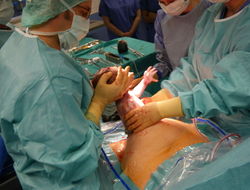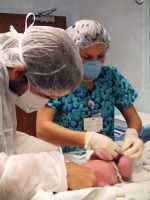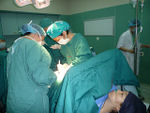Cesarean section
The Cesarean section, or C-section, is a surgical procedure in which a baby is delivered via an incision in either the abdominal wall or uterine wall, rather than through vaginal birth. A C-section usually occurs because of unforeseen issues during labor and birth, but can be scheduled ahead of time in certain circumstances. The C-section lends way for many more complications and risks, as well as an extension of the recovery period for the mother. The procedure can be very physically, as well as emotionally, draining.[1] Even though the procedure may be risky, it is in most cases a lot more safe and promising birth through the vaginal canal. The doctors, surgeons, and everybody else involved are specialized in the surgery and can ensure that they will do everything they can to help the mother to have a successful birthing experience.[2]
History
The use of the Cesarean section is seen in several different cultures and stories dating back to the ancient times. Greek mythology reveals Apollo's use of the C-section when he removed Asclepius from his mother's abdomen. Ancient Hindi, Roman, Grecian, and Egyptian folklore also refer to the use of a C-section. Depictions of the procedure can be seen in Ancient Chinese drawings as well. The true origin of the procedure remains unknown still. Some believe the origin to be the birth of Julius Caesar. In his time though, the C-section was only performed on women who were dying or already dead, but Caesar's mother lived to hear of his British invasion.[3]
Uses
About 32% of all pregnancies end in a C-section. There are many reasons why this may happen or why a C-section will be scheduled ahead of time. If the mother has any chronic medical conditions or infections such as HIV or herpes, a C-section may be required in order to protect the baby. Diseases in the mother can cause vaginal delivery to become extremely painful or dangerous, and the child may contract any infections that the mother has during. If the baby is suspected to or known to have any illnesses or infections prior to birth, the journey through the canal may worsen his symptoms, meaning that the Cesarean section would definitely benefit the baby more. Sometimes the baby may be too large to be delivered normally, or the mother's weight could affect the length of labor. Both of these would cause a C-section to become necessary. A C-section may also be required if there are any complications in the birth such as the baby's position, or if multiple children are being born. An unscheduled C-section may occur if the labor fails to start or stalls at any time, if the mother becomes too exhausted and distressed, if the umbilical cord prolapses, or if the uterine ruptures.[4]
Technique
There are several preoperative steps that must be taken in order to ensure a safe delivery via Cesarean section. The mother is usually asked not to consume any food for 12 hours prior to the operation, and to avoid clear liquids for the final 2 hours before the procedure. Before the surgery can begin, the mother must be hooked up to an intravenous (IV) line, and a Foley catheter must be connected to monitor the bladder and the urine levels. The doctor must also connect monitors to control blood pressure, pulse, and oxygen levels, as well as administer antibiotic prophylaxis. Finally, the surgeon and anesthesiologist will evaluate the patient and make sure all the necessary preoperative steps have been completed. The actual surgery may be carried out through one of two methods: laparotomy (through the abdominal wall) or hysterotomy (through the uterine wall). The laparotomy requires a midline infraumbilical, vertical, or transverse incision, while the hysterotomy requires a transverse or vertical incision. After the incision has been made, the patient will undergo fetal delivery, then uterine repair. If consulted beforehand, the patient may choose to have an IUD inserted during the procedure. Finally the incision is shut and the surgery is complete.[5]
Risks
As with any surgical procedure, there are many risks involved in the C-section. These can include infection at the site of the incision or in the uterine or bladder areas, excessive blood loss or injury to the organs. In addition, the mother may be required to stay at the hospital longer, as well as have an increase in length for her recovery period. The mother may react negatively to the medications, or may be in need of additional surgeries. Because the C-section is such an emotional and draining procedure, some women may find it difficult to bond with their new child at first. In regards to risks for the baby, the baby may be born prematurely or may face breathing difficulties. The baby may also face the risk of acquiring a fetal injury, such as a cut during the incision process.[6]
Recovery
The recovery after a Cesarean section is much more lengthy and strenuous than that of a vaginal birth. The mother may spend up to four days in the hospital after the arrival of her child, and may need to rest at home for around four to six weeks in order to feel normal again. To make the recovery process easier, the mother should lower her expectations and give herself a realistic amount of time to fully recover. The mother also needs to be careful in carrying out everyday activities and will need to take more time to rest than usual. She should always keep an eye on her incision, checking for any infections or unusual coloring, pain, or discharge. It is important to stay nourished and to take all the medications that the doctor provides, as well as exercising in small amounts.[4]
Video
An informational video about and a walk-through of the Cesarean section.
References
- ↑ C-sections: Giving Birth by Cesarean Section Babycenter. Web. Last Modified July 2015. Author Unknown.
- ↑ Hatfield, Heather. The Truth About C-sections WebMD. Web. Last Accessed Mar. 20, 2017.
- ↑ Cesarean Section-A Brief History U.S. National Library of Medicine. Web. Last modified July 26, 2013. Published November 3, 2015. Author Unknown.
- ↑ 4.0 4.1 Delivering by C-Section What To Expect. Web. Last Modified January 31, 2017. Author Unknown.
- ↑ Saint Louis, Hedwige. Cesarean Delivery Medscape. Web. Last Modified Sept. 22, 2016.
- ↑ Risks of a Cesarean Procedure American Pregnancy. Web. Last Modified Aug. 2015. Author Unknown.
| ||||||||||||||||||||




